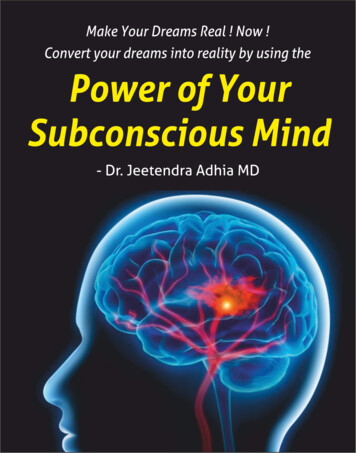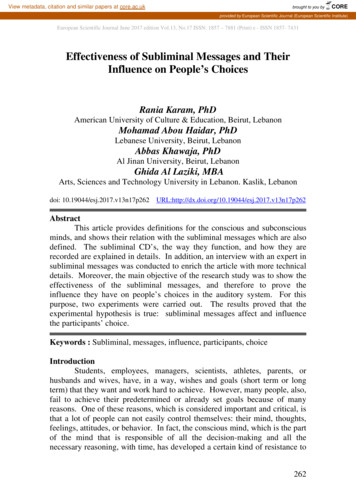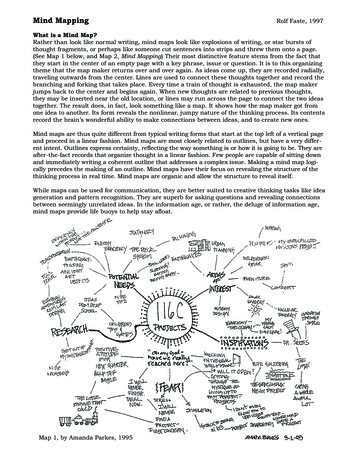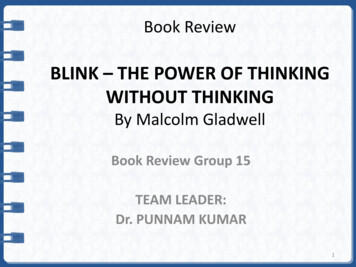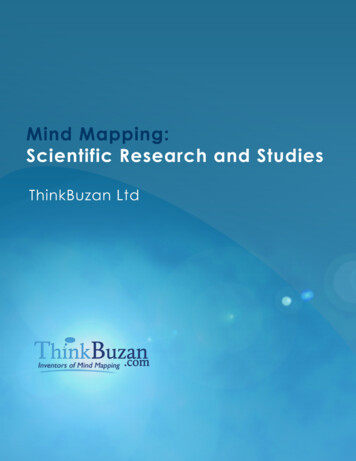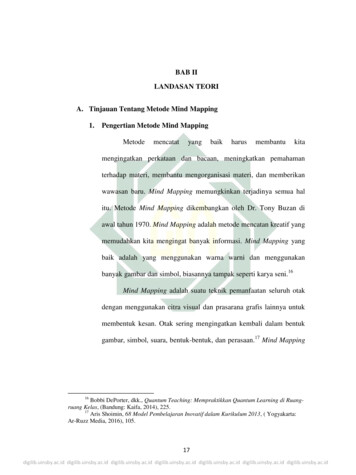
Transcription
Educ Psychol Rev (2011) 23:601–663DOI 10.1007/s10648-011-9178-3REVIEWEducating the Developing Mind:Towards an Overarching ParadigmAndreas Demetriou & George Spanoudis &Antigoni MouyiPublished online: 13 September 2011# The Author(s) 2011. This article is published with open access at Springerlink.comAbstract This essay first summarizes an overarching theory of cognitive organization anddevelopment. This theory claims that the human mind involves (1) several specializedstructural systems dealing with different domains of relations in the environment, (2) acentral representational capacity system, (3) general inferential processes, and (4)consciousness. These systems interact dynamically during development so that changesin each are related to changes in others. The changes in all systems and the changemechanisms are described. This theory integrates research and theorizing from cognitive,developmental, and differential psychology. Based on this theory, a model for education isproposed that specifies, first, educational priorities for different phases of developmentaccording to the cognitive developmental milestones associated with each phase. Thetheory also specifies how education can educate students to (1) construct mental models forthe sake of conceptual change, (2) use their central representational capacity efficiently, (3)advance analogical and deductive reasoning, (4) learn how to learn, and (5) become criticaland creative thinkers. The theory is offered as an overarching paradigm for the architecture,the development, and the education of the human mind.Keywords Assessment . Cognitive development . Conceptual change . Consciousness .Critical thinking . Education . Intelligence . Learning to learn . Mental models .Metarepresentation . Reasoning . Working memoryA. Demetriou (*) : G. SpanoudisDepartment of Psychology, University of Cyprus, P. O. Box 537, 1678 Nicosia, Cypruse-mail: ademetriou@ucy.ac.cyG. Spanoudise-mail: spanoud@ucy.ac.cyA. MouyiCenter for Educational Research and Evaluation, Nicosia, Cypruse-mail: mougi@ucy.ac.cy
602Educ Psychol Rev (2011) 23:601–663In the second half of the twentieth century, developmental and cognitive sciences were solidenough to start systematically informing educational policy and practice (e.g., Anderson etal. 2001; Linn and Eylon 2011; Olson 2003; Stearns 2006). However, we still have a longway to go in the direction of integrating educational science with psychological science inthe way modern engineering is integrated with the natural sciences. For this to be possible,a comprehensive theory of the developing mind is needed. This is the aim of the theoryproposed here. This theory integrates findings and concepts from the psychology ofintelligence, the psychology of cognitive development, and cognitive psychology. Ifproperly integrated, these traditions can lead to a unified theory of learning, understanding,and development.The integration attempted here initiates from our earlier empirical (Demetriou 2002;Demetriou et al. 1993, 2008; Demetriou and Kazi 2001, 2006) and theoretical work oncognitive development (Demetriou 1998, 2004, Demetriou et al. 2010a, b; Kargopoulosand Demetriou 1998; Demetriou and Raftopoulos 1999) and is expanded to include currentresearch and theorizing in all three fields mentioned above. The integration of the theorywith research and theory on educational implications and applications is new and is firstpresented here. This theory specifies the following:1. The architecture of the mind. That is, the general cognitive structures and processesunderlying understanding, problem solving, and learning across different domains andalso the processes underlying the operation of specialized domains of thought. Thus,the theory goes beyond theories which emphasize the importance of different domainsbut underestimate the role of central processes and constrains, such as Gardner’s theory(1983), and theories which stress the importance of central processes but minimize therole of domain-specific processes, such as Jensen’s (1998) or Piaget’s (1970) theory.2. The development of the mind. That is, the condition of the various general and domainspecific structures and processes during development, their dynamic relations, and themechanisms which are responsible for change and learning in different phases ofdevelopment. The theory integrates research and theory on developmental changes inrepresentational and information processing capacity (e.g., Case 1985; Halford 1993;Kail 1991; Pascal-Leone 1988) with research and theory on the development ofthought and consciousness (Demetriou 2000; Demetriou et al. 1993, 2002; Demetriouand Kazi 2001, 2006) to provide an integrated model explicating the development ofself-aware individuals that have a strong sense of unity, a personal style of functioning,and a differentiated profile of competence and modus operanti.3. Guidelines as to how educators can use this understanding of mind and its developmentto organize instructional content across diverse subject matter and to create teachingmethods that are appropriate for different individuals at different phases of learning.Obviously, social understanding and interaction are extremely important for educationboth as a frame where cognitive processes operate and as a major goal which aspires toeducate citizens well adapted in their cultural and social environment. Moreover,emotion and motivation are also important dimensions of cognitive functioning andeducation. Although this essay focuses on cognitive processes, for the sake ofcompleteness, we also briefly integrate into the theory considerations aboutmotivational and emotional processes.This essay is addressed to three groups of scholars: cognitive and developmentalscientists who would be interested to see how the cognitive, the differential, and thedevelopmental traditions are integrated into a unified theory of the developing mind and
Educ Psychol Rev (2011) 23:601–663603explore the implications of this theory for education; education policy makers and plannerswho need to tune important aspects of educational policy, such as setting major priorities forthe successive phases of education and curriculum development, with current thought andknowledge in the cognitive and the learning sciences; and, finally, this essay is addressed toclassroom teachers who would like to inform their teaching practices and decisions inrelation to the actual possibilities and weaknesses of their students.Thus, this essay includes two parts. The first part presents the psychological theory.Specifically, it outlines the architecture of the human mind, its development, and thedynamic relations between the various structures and processes in real and developmentaltime. The second part presents the implications of the theory for education.The Architecture and Development of the MindResearch and theory in psychometric (Carroll 1993; Demetriou 2002; Gustafsson andUndheim 1996; Hunt 2011; Jensen 1998), cognitive (Hunt 2002), and developmentalpsychology (Case 1992; Demetriou 1998; Demetriou et al. 1993, 2002, 2008, 2010a, b)converge on the assumption that the human mind is a universe of processes that areorganized into systems which carry out different tasks during real-time problem solving.The systems are: (1) specialized structural systems (SSS). These constitute a set of mentalprocesses that interface with several environmental domains. (2) The representationalcapacity system. This system is responsible for meeting representational and informationprocessing needs activated by the environment-oriented SSS or the systems to be discussedbelow. (3) The inference system is responsible for connecting and integrating informationand operations vis-à-vis the goal of the moment. (4) The consciousness system isresponsible for monitoring, controlling, and regulating the processes activated at a givenmoment. Figure 1 highlights this architecture. Below, we first outline the architecture anddevelopment of each of the systems. Then we discuss the interrelations between the varioussystems in real and developmental time and present relevant evidence.SSSEssentials andcategoriesEpisodicIntegrationREPRESENTATIONAL CAPACITYWM, STSSExecutiveControlSpace and timeCONSCIOUSNESSNumbers and quantitiesSelf-monitoringInteractions and causesSelf-representationAgents and personsLanguageMentalModelsProblem SolvingSelf-regulationSelf-awarenessReflection andrecursionCore operatorsMental operations; rulesand principles;Concepts, knowledgesystems, and AbductionFig. 1 General architecture of the human mindMetaRepresentation
604Educ Psychol Rev (2011) 23:601–663The architecture of the specialized structural systemsEach SSS includes processes that specialize in processing information coming fromdifferent domains of the environment. Five SSS were specified by research: (1) Categoricalthought deals with similarity–difference relations. Forming hierarchies of interrelatedconcepts about class relationships is an example of the domain of this system. (2)Quantitative thought deals with quantitative variations and relations in the environment.Mathematical concepts and operations are examples of the domain of this system. (3)Causal thought deals with cause effect relations. Representations about causal relationsbetween objects and persons and operations related to causality, such as trial-and-error orisolation of variables, that enable one to decipher causal relations belong to this system. (4)Spatial thought deals with orientation in space and the imaginal iconic representation of theenvironment. Mental maps of places or mental images of familiar persons and objects andoperations on them, such as mental rotation, belong to this system. (5) Social thought dealswith social relationships and interactions. The mechanisms for monitoring non-verbalcommunication or skills for dealing with social interactions belong to this system. TheseSSS were identified by a number of studies involving participants from preschool age toadulthood. Specifically, in factorial studies, all five SSS emerge as separate factors (Case etal. 2001; Demetriou and Bakracevic 2009; Demetriou and Efklides 1989; Demetriou et al.1993, 2002; Demetriou and Kazi 2001, 2006; Shayer et al. 1988). Moreover, together withcommon inferential processes, each of the SSS involves SSS-specific logical process forproblem solving (Kargopoulos and Demetriou 1998).SSS involve (1) core processes, (2) mental operations, and (3) knowledge and beliefs.Table 1 summarizes the main features of the SSS. Core processes are pre-adapted andfoundational inferential traps that impose their ready-made meaning on the aspect of theenvironment concerned. For example, categorical perception on the basis of shape,perception of the numerocity of small sets, depth perception in space, perception ofcausality, and human face preference in the social domain are examples of core process ineach SSS. Core processes are fundamental because they ground each domain into itsrespective environmental realm and they form the background for the development of theother levels of the SSS, namely, mental operations and knowledge and beliefs (Carey 2009;Cosmides and Tooby 1994; Gelman and Brenneman 1994). Mental operations arise as aresult of the dynamic interactions between domain-specific core processes and theinformational structures of the environment. The systems of operations within each domainemerge by differentiation of the core processes when these do not satisfy the understandingand problem-solving needs of the moment. Examples of mental operations are sorting in thecategorical SSS, numerical operations in the quantitative SSS, hypothesis testing in thecausal SSS, mental rotation in the spatial SSS, or emotion regulation in the social SSS.Knowledge and beliefs accumulate over the years as a result of the interactions of each SSSwith the respective domain, such as time reading, money values, and rules underlyingeveryday transactions in the quantitative system, mental images and mental maps in thespatial system, social attributions in the social domain, etc. (Carey 1985, 2009; Demetriouet al. 1992, 1993, 2002).The development of the SSSTable 2 summarizes the development of the SSS. With development, each of the domainsmoves along three dimensions: complexity, abstraction, and flexibility. As children growolder, they become able to deal with increasingly more representations simultaneously. This
Educ Psychol Rev (2011) 23:601–663605Table 1 Three levels of organization of each specialized system of thought and reasoningDomainCore processesMental operationsCategoricalPerception according toperceptual similarity;inductive inferencesbased on similarity–difference relationsConceptions andSpecification of the semanticmisconceptionsand logical relations betweenabout the worldproperties, classification;transformation of propertiesinto mental objects; constructionof conceptual systemsQuantitative Subitization; counting,pointing, bringing in,removing, sharingMonitoring, reconstruction,execution and control ofquantitative transformations,the four arithmetic operationsKnowledge and beliefsFactual knowledge aboutthe quantitative aspects ofthe world, algebraic andstatistical inference rulesStored mental images, mentalmaps, and scripts aboutobjects, locations, scenes,or layouts maintainedin the mindSpatialPerception of size, depth, Mental rotation, imageintegration, imageand orientation;reconstruction, locationformation ofand direction trackingmental imagesand reckoningCausalPerception of overtand covert causalrelationsTrial-and-error; combinatorialoperations; hypothesisformation;systematic experimentation(isolation of variables);model constructionKnowledge, attributions andunderstanding of thereasons underlying physicaland social events and thedynamic aspects of the worldSocialRecognition ofconspecifics,recognition ofemotionally ladenfacial expressionsDeciphering the mentaland emotional statesand intentions of others;organization of actionsaccordingly; imitation;decentering and takingthe other’s perspectiveSystem of social attributionsabout other persons, theirculture and their societyReasoningUse of the grammaticaland syntacticalstructures of languageIdentifying truth in information;abstraction of informationin goal-relevant ways;differentiation of thecontextual from the formalelements; elimination ofbiases from inferential process;securing validity of inferenceKnowledge about grammar,syntax and logicalreasoning; metalogicalknowledge about natureand justifiability of logicalinferences; metacognitiveawareness, knowledge,and control of inferentialprocessespermits them to consider alternative representations of a situation or alternative actionsupon these representations or the situation itself. Increasing complexity necessitates theelaboration of relations between representations, which results into abstractions which aresubsequently encoded and processed as representations, thereby leading to increasinglyabstract systems of representations. Envisaging representations from the point of each otherand focusing on their relations gradually frees thought from the specifics of particularrepresentations, rendering it increasingly fluid and flexible (Table 3).Thus, development of the SSS is a continuous process of emergence, differentiation, andintegration of new representations. However, this is one aspect of development. Somechanges at some periods alter how the world is viewed by the developing person. Thesechanges may be taken as milestones that are important both from the point of view of theperson’s own subjective experience and for his or her relations with the world.
egoriesSingle criterionclassesLogical multiplicationLogical multiplicationon unfamiliar contextFlexible logicalmultiplicationStrategic classificationincluding relevant–irrelevant informationMultilevel classes.Networks ofclassification 415–16Integrated theorybuildingGeneralized conceptof variableLogical validityof propositionsImagination ofthe non realSuppositions,isolation ofvariablesPersonal imaginalworlds, aestheticcriteriaOriginality inmental imagesLogical necessityRepresentation ofcomplex realitiesTestable theoriesin actionHypothesis drivenexperimentationExplicit inference“Fluent” ss of specializedmental operationswithin a domainIntegrated cognitivetheoryGrasp of formalrelationsReasoning onreasoningDifferentiation betweenclearly differentdomains (spacevs. maths)Differentiation betweencognitive functions(memory vs. attention)Grasp of the constructivenature of thoughtUnderstanding the streamof consciousness andinner speechPermission rulesSingle spatialdimensions oroperationsCoordination ofproto-causalschemesAlgebraic reasoningbased on mutuallyspecified symbolsystemsProportional reasoning.Coordination ofsymbolic structuresConstruction ofsimple mathrelations (e.g.,a 5 8)Number conceptsand quantitativedimensionsCoordination ofproto-quantitativeschemesDifferentiation betweenmodalities (perceptionvs. mary reasoningSimilarity-basedinductive inferenceand event basedprobabilistic inferenceInferenceGlobal imagesHolistic sceneimagesSpaceProto-causalschemesEpisodic eventsequencesSubitization-based andapproximate numbersProto-quantitativeschemesCauseNumberTable 2 Modal characteristics of the specialized domains with development606Educ Psychol Rev (2011) 23:601–663
Inhibit irrelevant tems.Bind items according to typeand time of presentation.Metarepresent new conceptsand symbolize.Model templates for conceptualchange, such as bridging,fusing, differentiating,and eliminating Concepts.Model templates for the basicmental operations in eachSSS, such as classification(categorical), models for causalrelations (causality), for mentalnumber line or arithmeticoperations (quantity), forvisualization or spatialcoordinates (space).Monitor ongoingperformance.Keep track of the flow ofinformation and update(rehearse) it for as longas needed.Manage more than onetask simultaneously(e.g., by alternatingbetween blocks or typesof information, if needed).Conceptual changeWorking memoryKnowledge (1) acquisition(observation, asking,reading, etc.), (2) retention(rehearsal, association), and(3) evaluation (experiment,logical validation).Metarepresent newreasoning patternsand symbolize.One’s own strengths andweaknesses in differentdomains and processes.Actions regulating processing(e.g., stimulus engagement,ignoring distractors, reflection)Differentiate between logicallyMental operations in eachnecessary and likely conclusions.SSS as knowledgeResist certainty about conclusionsextraction mechanisms.unless really logically necessary.Processing demands ofSpot contradictions between(1) mental operationspremises and conclusions(e.g., mental rotationand construct alternative modelsvs. arithmetic operations), (2)for premises and conclusions.representations (e.g., images vs.Withhold judgment until tonumbers), (3) informationexamine all relations involved.type, organization or volume.Differentiate between types ofreasoning (e.g., deductive vs.inductive) and logical forms(e.g., disjunction,conjunction, etc.).Identify central issuesand assumptions.Differentiate between:Learning as (1) knowledgeacquisition, (2) conceptualchange, and (3) acquisitionof problem solving skills.Decontextualize inference byinterpreting the premisesanalytically and differentiatingthem from their content and theconclusion (use key elementssuch as the connectives).Metarepresent new decisionsand symbolize.Reflect on the nature ofknowledge (what is truth,what is evidence, what isreason or cause, what is moreimportant, reason or evidence).Revise approach or perspective,if appropriate.Adopt an informed preferencebased on evidence, argument,and perspective.Stay open-minded, skepticaland questioning. Tolerateambiguity. Protect judgmentfrom your own biases.Envisage alternative modelsand associate each withsupportive evidence, logicalsubstantiation, conceptualor belief systems.Critical thinkingLearning to learnReasoningTable 3 Summary of principles for educating the developing mindEduc Psychol Rev (2011) 23:601–663607
608Educ Psychol Rev (2011) 23:601–663Emergence of representationsAll systems are present at birth. There is strong evidence that the core processes ofcategorical (Butterworth 1998; Carey 2009), quantitative (Dehaene 1997; Piazza 2010;Sloutsky and Fisher 2011), causal (Haun et al. 2010; Keil 2011), spatial (Haun et al. 2010),and social (Molenbergs et al. 2009; Rizzolatti and Craighero 2004) thought are present inthe first weeks of life. The engagement of core operators with their respective aspects of theenvironment generates representations that provide the behavioral or mental analogues ofthe basic laws of physics, biology, and psychology. These enable the infant to interact withincreasing efficiency with physical objects, animals, and other humans. Therefore, thedevelopment in the first 2 years of life suggests, contrary to Piaget, that this period of life,far from being simply sensorimotor, is richly conceptual (Carey 2009; Gelman 2003;Mandler 2004). According to Carey (2009), the major domains of infant cognitivedevelopment are objects (the physical world), agency (the psychological world), andnumber. These are envelop categories which include concepts and categories about theidentity, the spatial, and the causal relations of objects; the active self which acts as a causalagent for objects and other persons generating self-knowledge and knowledge about others(agency); and the quantitative relations between objects and beings.However, thought at this period is constrained by limited concentration and floatingattention that is easily attracted by sensory variation in the environment. These limitations,together with the lack of language, hinder drastically the integration of experience. As aresult, the infant’s conceptual world is incoherent and content- and context-bound. It needsto be stressed, however, that what appears as a limitation from one point of view is anadvantage from another. Specifically, floating attention and ensuing superficial processingof information about the world enables the infant to generate a rich pool of experience andknowledge about the world at a period of universal inexperience and ignorance that will bepruned, elaborated, differentiated, and integrated in the following phases.Differentiation of representationsThe gradual emergence of language during the second year of life brings representations assuch into focus so that they can be reflected upon and elaborated. The explosion of the“why” questions at this phase (Brown 1968; McCune 2008) is indicative of a reorientationof the infants’ knowing priorities from the world itself to their own representations aboutthe world. In a sense, the infants appear to realize, though not explicitly, that it is time towork on the representations already constructed.Two-year-olds represent, but they cannot metarepresent. DeLoache and Burns (1994)showed a dramatic developmental change between 24 and 30 months of age in this regard.Specifically, 24-month-olds could not use a picture to retrieve an object whereas 30-month-oldscould. Therefore, in the middle of the third year of life, children start to be able to view picturesas representations of current reality. In line with these findings, Dalke (1998) showedthat 3-year-olds have some ability to make and use maps as a guide for their actions (e.g.,where to look for an object). Huttenlocher et al. (2008) showed that this ability developsgradually from less (e.g., placing an object in actual place following a map at the age of3 years) to more complex tasks (e.g., retrieving an object following a map at the age of4 years).Thus, at about the age of 3–4 years, children start to differentiate representations fromeach other and from the objects they represent. For example, they can see a toy car as arepresentation of real cars and as an object in itself. DeLoache (1995, 2000) called this
Educ Psychol Rev (2011) 23:601–663609emerging differentiation of representations dual representation. Dual representations enablechildren to reflect on and operate explicitly on representations as tokens of reality. Thus,they represent a major milestone in development because they open the way for theintentional use of symbols and symbol systems, such as writing.As a result, preschoolers start to build concepts in the various environment-orienteddomains. There must be at least two representations to conceive of a class (e.g., “fruit”), aquantity (e.g., more or less), a cause effect relation, or a spatial relation (e.g., “above”; Case1985; Demetriou 1998; Fischer 1980). Moreover, they start to understand the multifacetednature of the world, as indicated by their understanding of the appearance reality distinction,because they can represent an object in its present and in an earlier condition (Flavell et al.1995), and their acquisition of a theory of mind, because they can understand that the samething can be represented differently by two persons (Wellman 1990).Integration of representationsAnother important milestone comes at about the age of 7–8 years. With practice andincreasing awareness about representations (Demetriou and Kazi 2006; Flavell et al. 1995),children begin to realize that representations constrain each other. For example, words in asentence constrain how other words will be used and sentences constrain the meaning of thesentences to follow (Brown 1968; McCune 2008). This is the beginning of the grasp oflogical necessity (Miller et al. 2000; Moshman 1990, 1994). With logical necessity as areference criterion for the validity of the relations between representations, children canstart to systematically build alternative mental models for concepts and relations (Ricco2010) and to represent the underlying relations between concepts or mental operations. Forexample, in the domain of categorical thought, systematic classification starts to be possiblebecause a criterion may be preselected and applied in order to specify the identity of objectsand their similarity relations (e.g., color, shape, etc.). This criterion may be used to classifythings on the basis of having or not having the attributes specified by the criterion. Thus,the logical relation of class inclusion can be grasped, indicating that semantic networks arebound by obligatory relations.Conditional representationsA third milestone comes at the beginning of adolescence, when adolescents become able toconstruct conditional representations. Conditional representations enable the thinker to viewsystems of representations from the point of view of each other. Technically speaking, theycan integrate at least two dimensions with at least two levels each (e.g., they graspproportionality and they formulate alternative hypotheses which they can test withespecially designed experiments).The meaning of each component representation in conditional representations emergesfrom the relations of this representation with all other representations in the system.Consistency and coherence in these representations gears on the relations between therelations involved rather than in the relations between representations and the objectsrepresented (e.g., in the proportional relation 2/4:3/x, x is derived from the relations ratherthan from the numbers themselves). Logical necessity is fully established at this phase andacquires its full use as a gauge of the fit of each representation or variation in the system. Inthe previous phase, logical necessity is a tool for evaluating consistency within concepts.Now it is a tool for guiding the exploration of the relations across concepts. Therefore,empirically invalid or counterintuitive representations are acceptable if they can be derived
610Educ Psychol Rev (2011) 23:601–663from the logical relations involved. As a result, each representation in a system ofconditional representations is a point of variation, given the relations involved. Thus, newrepresentations can be introduced and the implications examined from the point of view ofall other representations, given the relations that bind them. This results in thetransformation of thought from being descriptive and organizational to suppositional andforesighted (Demetriou et al. 1993; Demetriou and Kyriakides 2006).Differentiation of thought from knowledgeThe next milestone comes at about the end of secondary school or in the early 20s. Youngadults differentiate (1) between thought processes vis-à-vis their use for different aspects ofknowledge acquisition and problem solving and (2) between thought, as a system ofprocessing, and knowledge, as information about the world. That is, they understand thatdifferent knowledge or belief systems governing the operation of social and cultural groupsare constrained by rules related to the values of these groups rather than from cognitive orinferential processes as such. It is understood that conclusions or interpretations may varyacross systems even when the same inferential or thought processes are used. Therefore,knowledge or belief systems may be compared, integrated, or used separately according togoals or needs (Demetriou and Bakracevic 2009; Demetriou and Kazi 2001, 2006;Reynolds et al. 2005; Schaie 1996).These changes interweave with the social life of the adult which requires the flexibility that isnecessary to consider and negotiate the multiple perspectives that are usually associated withdifferent individuals, groups, or institutions adults normally interact with. Thus, on the onehand, relativistic and dialectical thinking (Basseches 1984; King and Kitchener 1994; Riegel1973) emerges from the flexibility that is associated with the multiplicity of p
a comprehensive theory of the developing mind is needed. This is the aim of the theory proposed here. This theory integrates findings and concepts from the psychology of intelligence, the psychology of cognitive development, and cognitive psychology. If properly integrated, these traditions can lead to a unified theory of learning, understanding,



